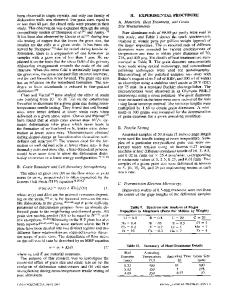The effect of grain size and plastic strain on slip length in 70-30 brass
- PDF / 1,239,297 Bytes
- 6 Pages / 612 x 792 pts (letter) Page_size
- 10 Downloads / 398 Views
I.
INTRODUCTION
M A N Y investigators have studied plastic deformation and work hardening of single crystals, bicrystals, and polycrystals. As has been reviewed, 1-5 many qualitative and quantitative equations have been developed to describe deformation behavior, in some cases incorporating the effect of boundaries on slip in polycrystals. Ashby 6"v classified dislocations stored in polycrystals during the course of plastic deformation into two groups: "statistically stored" dislocations which accumulate by randomly encountering and mutually trapping in each grain, and "geometrically-necessary" dislocations which are present to meet the requirement of the deformation compatibility between grains in the boundary regions. He derived a relation among pC; (density of "geometrically-necessary" dislocations), A~ (geometric slip distance), and pS (density of "statistically stored" dislocations). He inferred that Ac, which was assumed to be proportional to the grain size or the interphase separation and independent of strain, could not be measured. Thus he assumed that Ac is a constant determined by the microstructure and does not change with plastic strain. Considering observations on slip both in the grain boundary region and in the interior region of the grain, as has been reviewed, 8 Thompson, et al. 9 derived the approximate equation
As(K2
o'= o'0+ (1-~-)(~sl) +-j\~'-~/
[1]
where or0 and KI are constants, K2 is the Hall-Petch slope for yielding (As = d at yield), d is the grain size (average diameter), and As is the statistical slip line length, distinguished from A~. Thompson, et al. assumed that since geometrical and statistical dislocations are not physically different, the slip length of each would necessarily be As. As is a function of grain size d and strain e; d is the upper limit for As. Evaluation was accomplished 9 with an optimizing As function, and o'0, K1, and /(2 in Eq. [1] were found by. a multiple regression computer technique, to obtain values in good agreement with experimental stress-strain curves, for H. DONG, formerly with Carnegie-Mellon University, is now with Jilin Institute of Engineering, Changchun, China. A. W. THOMPSON is Professor, Department of Metallurgical Engineering and Materials Science, Carnegie-Mellon University, Pittsburgh, PA 15213. Manuscript submitted June 8, t984. METALLURGICAL TRANSACTIONS A
aluminum, copper, and brass (o'0 was zero). This technique also provided the As - e curves for several values of grain size d. These curves have not yet been compared to systematic experimental data. It is the purpose of the present paper to obtain an experimental expression of the function As (e, d) and to consider models for the effects of the grain boundary on slip in polycrystalline brass.
II.
EXPERIMENTS
The material was the 70-30 brass used in earlier work] ~ Flat tensile specimens of cross section 12.7 mm x 6.35 mm and gage length 25.4 mm were recrystallized in 1 atm argon for I hour each at the temperatures 450 ~ 680 ~ and 780 ~ to obtain the required grain sizes. After
Data Loading...











